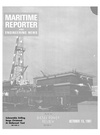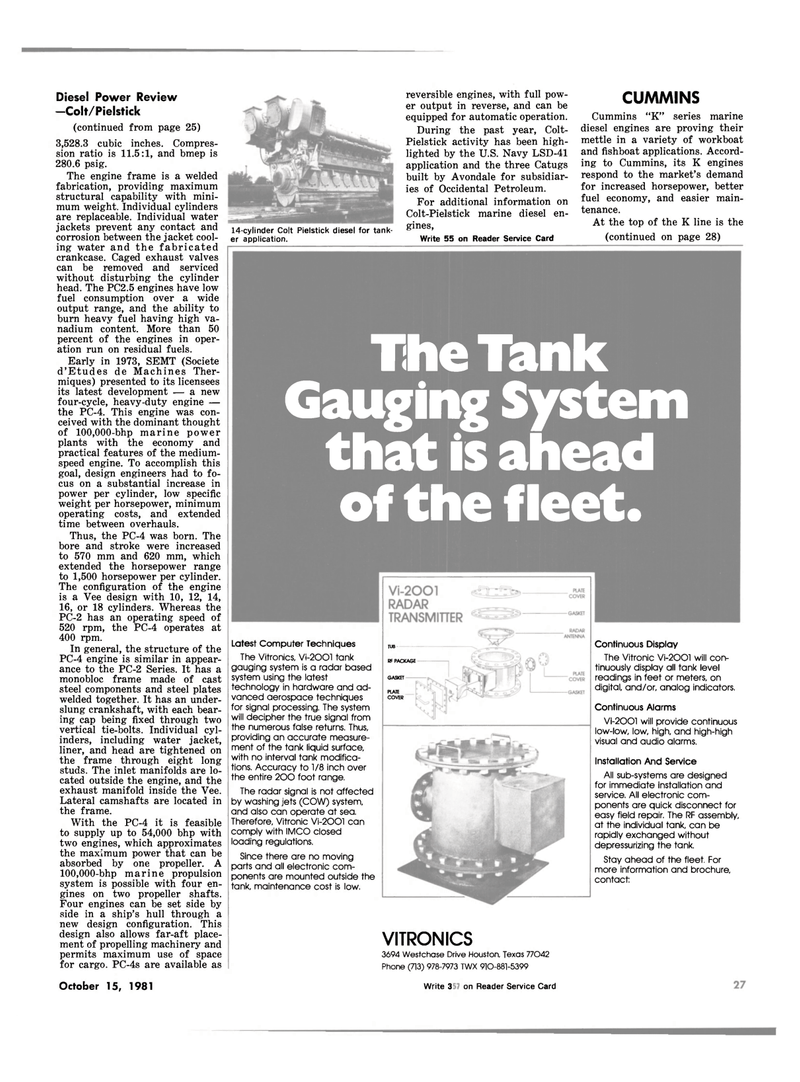
Page 25: of Maritime Reporter Magazine (October 15, 1981)
Read this page in Pdf, Flash or Html5 edition of October 15, 1981 Maritime Reporter Magazine
Diesel Power Review —Colt/Pielstick (continued from page 25) 3,528.3 cubic inches. Compres- sion ratio is 11.5:1, and bmep is 280.6 psig.
The engine frame is a welded fabrication, providing maximum structural capability with mini- mum weight. Individual cylinders are replaceable. Individual water jackets prevent any contact and corrosion between the jacket cool- ing water and the fabricated crankcase. Caged exhaust valves can be removed and serviced without disturbing the cylinder head. The PC2.5 engines have low fuel consumption over a wide output range, and the ability to burn heavy fuel having high va- nadium content. More than 50 percent of the engines in oper- ation run on residual fuels.
Early in 1973, SEMT (Societe d'Etudes de Machines Ther- miques) presented to its licensees its latest development — a new four-cycle, heavy-duty engine — the PC-4. This engine was con- ceived with the dominant thought of 100,000-bhp marine power plants with the economy and practical features of the medium- speed engine. To accomplish this goal, design engineers had to fo- cus on a substantial increase in power per cylinder, low specific weight per horsepower, minimum operating costs, and extended time between overhauls.
Thus, the PC-4 was born. The bore and stroke were increased to 570 mm and 620 mm, which extended the horsepower range to 1,500 horsepower per cylinder.
The configuration of the engine is a Vee design with 10, 12, 14, 16, or 18 cylinders. Whereas the
PC-2 has an operating speed of 520 rpm, the PC-4 operates at 400 rpm.
In general, the structure of the
PC-4 engine is similar in appear- ance to the PC-2 Series. It has a monobloc frame made of cast steel components and steel plates welded together. It has an under- slung crankshaft, with each bear- ing cap being fixed through two vertical tie-bolts. Individual cyl- inders, including water jacket, liner, and head are tightened on the frame through eight long studs. The inlet manifolds are lo- cated outside the engine, and the exhaust manifold inside the Vee.
Lateral camshafts are located in the frame.
With the PC-4 it is feasible to supply up to 54,000 bhp with two engines, which approximates the maximum power that can be absorbed by one propeller. A 100,000-bhp marine propulsion system is possible with four en- gines on two propeller shafts.
Four engines can be set side by side in a ship's hull through a new design configuration. This design also allows far-aft place- ment of propelling machinery and permits maximum use of space for cargo. PC-4s are available as 14-cylinder Colt Pielstick diesel for tank- er application. reversible engines, with full pow- er output in reverse, and can be equipped for automatic operation.
During the past year, Colt-
Pielstick activity has been high- lighted by the U.S. Navy LSD-41 application and the three Catugs built by Avondale for subsidiar- ies of Occidental Petroleum.
For additional information on
Colt-Pielstick marine diesel en- gines,
Write 55 on Reader Service Card
CUMMINS
Cummins "K" series marine diesel engines are proving their mettle in a variety of workboat and fishboat applications. Accord- ing to Cummins, its K engines respond to the market's demand for increased horsepower, better fuel economy, and easier main- tenance.
At the top of the K line is the (continued on page 28)
The Tank Gauging System that is ahead of the fleet.
Latest Computer Techniques
The Vitronics, Vi-2001 tank gauging system is a radar based system using the latest technology in hardware and ad- vanced aerospace techniques for signal processing. The system will decipher the true signal from the numerous false returns. Thus, providing an accurate measure- ment of the tank liquid surface, with no interval tank modifica- tions. Accuracy to 1/8 inch over the entire 200 foot range.
The radar signal is not affected by washing jets (COW) system, and also can operate at sea.
Therefore, Vitronic Vi-2001 can comply with IMCO closed loading regulations.
Since there are no moving parts and all electronic com- ponents are mounted outside the tank, maintenance cost is low.
Continuous Display
The Vitronic Vi-2001 will con- tinuously display all tank level readings in feet or meters, on digital, and/or, analog indicators.
Continuous Alarms
Vi-2001 will provide continuous low-low, low, high, and high-high visual and audio alarms.
Installation And Service
All sub-systems are designed for immediate installation and service. All electronic com- ponents are quick disconnect for easy field repair. The RF assembly, at the individual tank, can be rapidly exchanged without depressurizing the tank.
Stay ahead of the fleet. For more information and brochure, contact:
VITRONICS 3694 Westchase Drive Houston, Texas 77042
Phone (713) 978-7973 TWX 910-881-5399
TUB —
Rf PACKAGE
GASKET
PLATE
COVER
October 15, 1981 Write 3432 on Reader Service Card 27

 24
24

 26
26
